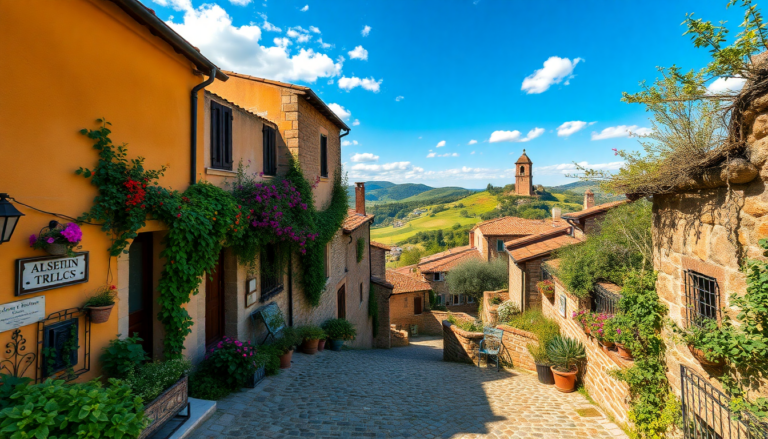Argomenti trattati
Imagine a place where the chaos of city life fades into the background, replaced by serene landscapes and the sound of nature. For many, the allure of escaping to a quieter, simpler life is irresistible. Italy, known for its rich history and stunning landscapes, also hides some of the smallest villages, often overlooked by tourists. These tiny communities, with populations ranging from 33 to 52 inhabitants, offer a glimpse into a slower pace of life and the chance to experience Italy beyond the typical tourist routes.
Morterone: a medieval alpine village
At the heart of the Italian Alps lies Morterone, a village steeped in history dating back to the 13th century. Once home to around 320 residents during the 16th century, this quaint settlement has seen its population dwindle to just 33 souls as of the latest census. Morterone’s picturesque streets and ancient stone houses tell tales of a time when coal production thrived, leading to significant deforestation. The village’s rich history, combined with its breathtaking mountain views, makes it a fascinating spot for those seeking solitude and a connection to the past.
Pedesina: charm in high Valtellina
Nestled in the high Valtellina, Pedesina is another hidden gem that boasts an enchanting atmosphere. This small village, with only 35 residents, features a stunning church dedicated to Sant’Antonio, adorned with an exquisite fresco by Cipriano Valorsa from 1564. The terraced agricultural fields and chestnut groves surrounding Pedesina create a pastoral scene that feels like a step back in time. For those who appreciate the beauty of nature and history, Pedesina offers a unique experience that is hard to find elsewhere.
Briga Alta: a glimpse into the past
Briga Alta, located in the province of Cuneo, is comprised of charming hamlets, including Piaggia, Upega, and Carnino. With a population of just 41, this village has a rich historical tapestry, once part of a larger commune before the post-World War II division. The ancient churches dedicated to San Giacomo and Madonna della Neve serve as a reminder of Briga Alta’s heritage. The village’s coat of arms, bearing the Latin phrase “Fracta resurget” or “broken, it will rise again,” symbolizes its resilience through history, making it a compelling destination for history enthusiasts.
Macra: a mountain retreat
Macra, another charming village in the Val Maira region of Cuneo, has become a haven for those seeking tranquility. With a population of only 45, this idyllic setting features rural hamlets that reflect a traditional pastoral lifestyle. The village’s economy once thrived on agriculture and livestock, but emigration has left behind its ancient stone houses and winding mule tracks, creating a picturesque landscape steeped in cultural heritage. Visitors can immerse themselves in a slower rhythm of life, far from the hustle and bustle of modern society.
Ingria: the ancient mountain world
Ingria, situated in the enchanting Val Soana, stands at an elevation of about 1,100 meters in the Gran Paradiso National Park. This quaint village, home to 46 residents, is enveloped by lush beech and chestnut forests, reflecting a timeless beauty. The traditional stone and wooden structures, with roofs made from local stone slabs, lend Ingria a distinct character. Known as a “small ancient mountain world,” it offers a perfect escape for those longing for a retreat into nature, showcasing the best of Italy’s rural charm.
Rocca de’ Giorgi: a noble history
Rocca de’ Giorgi, perched in the upper Scuropasso valley, is steeped in noble history, having been home to many aristocratic families over the centuries. With its medieval castle ruins and Villa Fornace, the area invites visitors to explore its rich past. The village’s name, derived from the Giorgi family, echoes through its ancient streets. Today, with a population of just 52, Rocca de’ Giorgi is a peaceful destination for those interested in Italy’s historical architecture and picturesque landscapes.
Cervatto: alpine traditions
Located in Valsesia at over a thousand meters above sea level, Cervatto is known for its long-standing alpine traditions and stunning mountain views. Despite being fragmented into seven hamlets, the village retains a close-knit community spirit. With only 47 inhabitants according to the latest census, Cervatto once thrived as a summer retreat for the bourgeois families of Piedmont and Lombardy, who sought solace in its tranquil environment. Today, the village still reflects its agricultural roots, with stone houses and ancient village fountains that speak of a simpler time.
Exploring Torresina and Moncenisio
Torresina, another charming village in Piedmont, shares its population of 47 with Cervatto. It features narrow valleys, dense fir forests, and high-altitude pastures, creating an idyllic alpine landscape. Visitors will find a rich tapestry of rural chapels and a parish church dedicated to San Giovanni Battista, reflecting the area’s deep-rooted traditions. Similarly, Moncenisio, with 49 residents, is rich in history, lying at the border with France and surrounding the picturesque artificial lake. The village offers a serene atmosphere and a connection to the ancient Alpine passage that linked Italy to Savoy, making it an intriguing spot for history buffs.
These small villages, with their unique stories and breathtaking landscapes, invite travelers to step off the beaten path and embrace the beauty of Italy’s hidden corners. Each village offers a chance to connect with nature, experience history firsthand, and enjoy a slower pace of life that is increasingly rare in our fast-paced world. Whether you’re seeking solitude, adventure, or simply a break from the everyday grind, these tiny communities provide the perfect backdrop for a memorable getaway.

